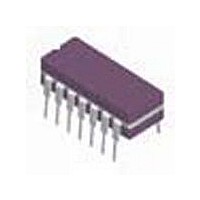LM124AJ/883 National Semiconductor, LM124AJ/883 Datasheet - Page 15

LM124AJ/883
Manufacturer Part Number
LM124AJ/883
Description
MIL SPEC NATIONAL SEMI IC
Manufacturer
National Semiconductor
Datasheet
1.LM124AJ883.pdf
(28 pages)
Specifications of LM124AJ/883
Rail/rail I/o Type
No
Number Of Elements
4
Unity Gain Bandwidth Product
1MHz
Common Mode Rejection Ratio
70dB
Input Offset Voltage
2@5VmV
Input Bias Current
10nA
Single Supply Voltage (typ)
5/9/12/15/18/24/28V
Power Dissipation
1.26W
Voltage Gain In Db
93.98dB
Power Supply Rejection Ratio
65dB
Power Supply Requirement
Single/Dual
Shut Down Feature
No
Single Supply Voltage (min)
3V
Single Supply Voltage (max)
32V
Dual Supply Voltage (min)
±1.5V
Dual Supply Voltage (max)
±16V
Technology
Bipolar
Operating Temp Range
-55C to 125C
Operating Temperature Classification
Military
Mounting
Through Hole
Pin Count
14
Package Type
CDIP
Slew Rate
0.1V/us
Lead Free Status / RoHS Status
Not Compliant
Available stocks
Company
Part Number
Manufacturer
Quantity
Price
Company:
Part Number:
LM124AJ/883C
Manufacturer:
TI
Quantity:
9 055
Company:
Part Number:
LM124AJ/883QS
Manufacturer:
NS
Quantity:
6 231
Part Number:
LM124AJ/883QS
Manufacturer:
NS/国半
Quantity:
20 000
Application Hints
The LM124 series are op amps which operate with only a
single power supply voltage, have true-differential inputs, and
remain in the linear mode with an input common-mode volt-
age of 0 V
power supply voltage with little change in performance char-
acteristics. At 25°C amplifier operation is possible down to a
minimum supply voltage of 2.3 V
The pinouts of the package have been designed to simplify
PC board layouts. Inverting inputs are adjacent to outputs for
all of the amplifiers and the outputs have also been placed at
the corners of the package (pins 1, 7, 8, and 14).
Precautions should be taken to insure that the power supply
for the integrated circuit never becomes reversed in polarity
or that the unit is not inadvertently installed backwards in a
test socket as an unlimited current surge through the resulting
forward diode within the IC could cause fusing of the internal
conductors and result in a destroyed unit.
Large differential input voltages can be easily accommodated
and, as input differential voltage protection diodes are not
needed, no large input currents result from large differential
input voltages. The differential input voltage may be larger
than V
provided to prevent the input voltages from going negative
more than −0.3 V
resistor to the IC input terminal can be used.
To reduce the power supply drain, the amplifiers have a class
A output stage for small signal levels which converts to class
B in a large signal mode. This allows the amplifiers to both
source and sink large output currents. Therefore both NPN
and PNP external current boost transistors can be used to
extend the power capability of the basic amplifiers. The output
voltage needs to raise approximately 1 diode drop above
ground to bias the on-chip vertical PNP transistor for output
current sinking applications.
For ac applications, where the load is capacitively coupled to
the output of the amplifier, a resistor should be used, from the
+
without damaging the device. Protection should be
DC
. These amplifiers operate over a wide range of
DC
(at 25°C). An input clamp diode with a
DC
.
15
output of the amplifier to ground to increase the class A bias
current and prevent crossover distortion.
Where the load is directly coupled, as in dc applications, there
is no crossover distortion.
Capacitive loads which are applied directly to the output of the
amplifier reduce the loop stability margin. Values of 50 pF can
be accommodated using the worst-case non-inverting unity
gain connection. Large closed loop gains or resistive isolation
should be used if larger load capacitance must be driven by
the amplifier.
The bias network of the LM124 establishes a drain current
which is independent of the magnitude of the power supply
voltage over the range of from 3 V
Output short circuits either to ground or to the positive power
supply should be of short time duration. Units can be de-
stroyed, not as a result of the short circuit current causing
metal fusing, but rather due to the large increase in IC chip
dissipation which will cause eventual failure due to excessive
junction temperatures. Putting direct short-circuits on more
than one amplifier at a time will increase the total IC power
dissipation to destructive levels, if not properly protected with
external dissipation limiting resistors in series with the output
leads of the amplifiers. The larger value of output source cur-
rent which is available at 25°C provides a larger output current
capability at elevated temperatures (see typical performance
characteristics) than a standard IC op amp.
The circuits presented in the section on typical applications
emphasize operation on only a single power supply voltage.
If complementary power supplies are available, all of the stan-
dard op amp circuits can be used. In general, introducing a
pseudo-ground (a bias voltage reference of V
operation above and below this value in single power supply
systems. Many application circuits are shown which take ad-
vantage of the wide input common-mode voltage range which
includes ground. In most cases, input biasing is not required
and input voltages which range to ground can easily be ac-
commodated.
DC
to 30 V
DC
.
+
/2) will allow
www.national.com












